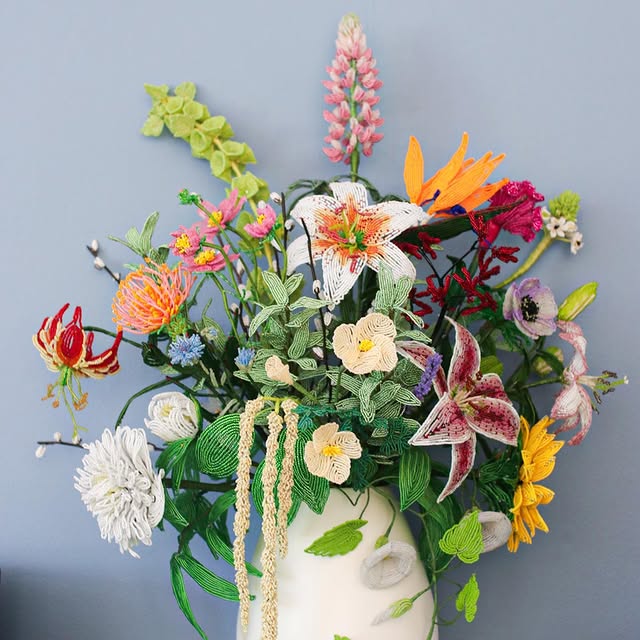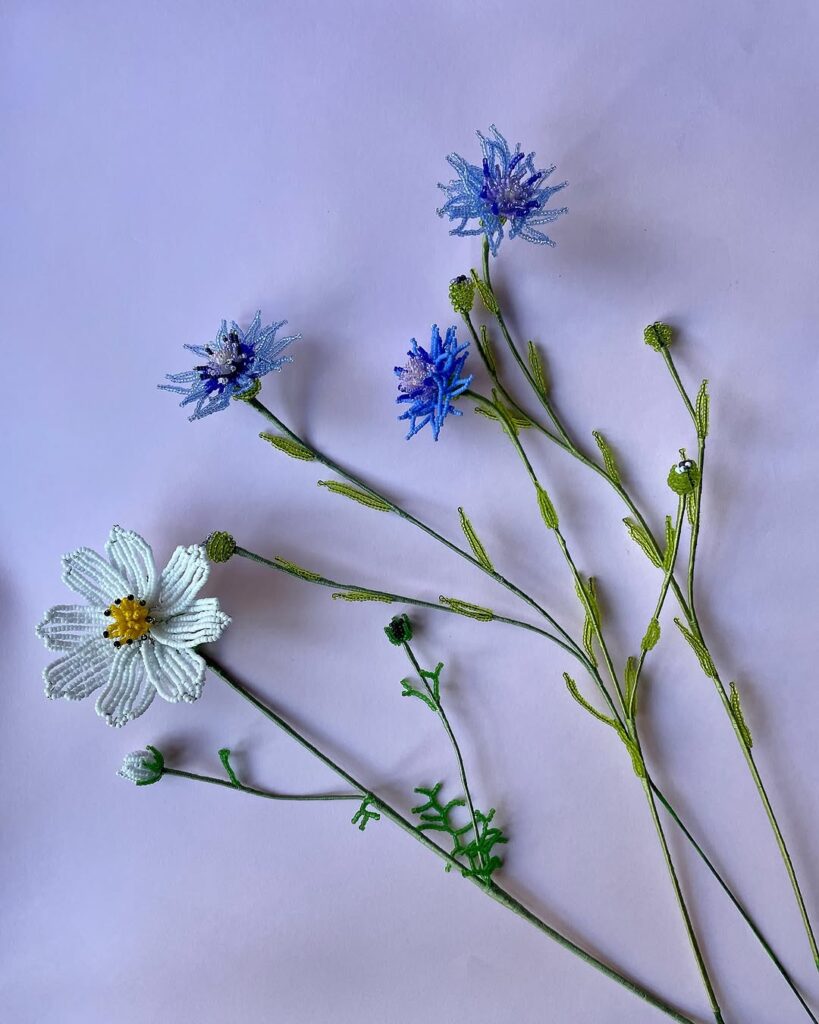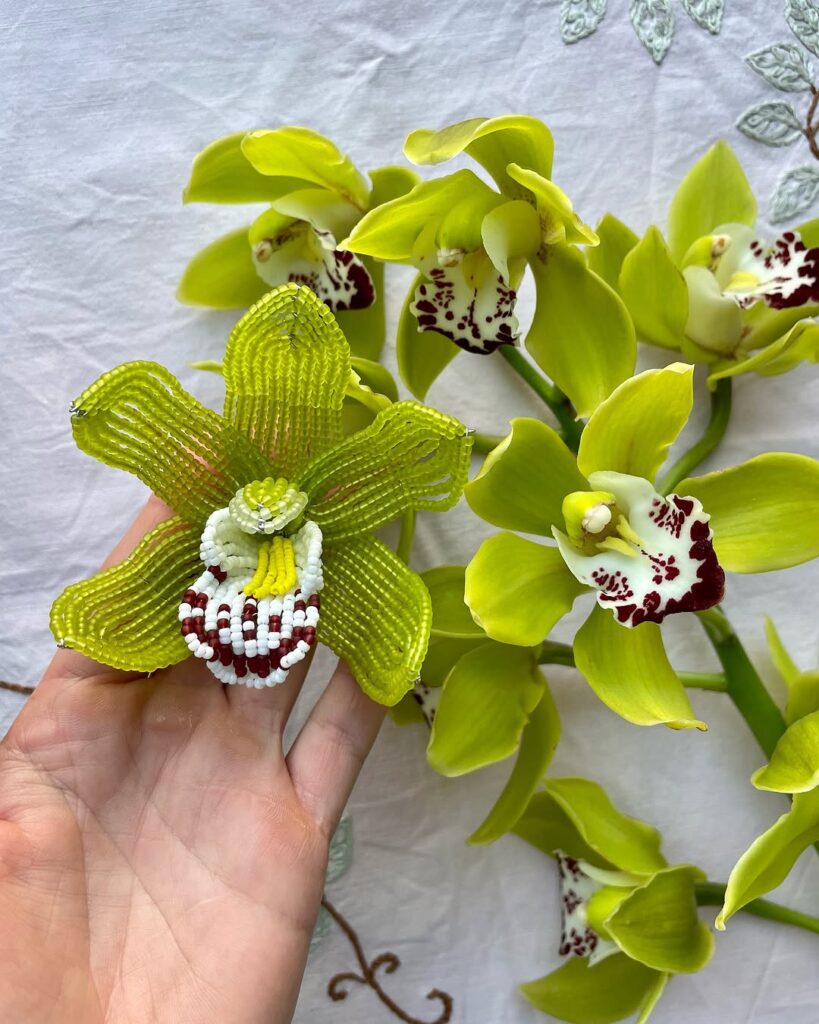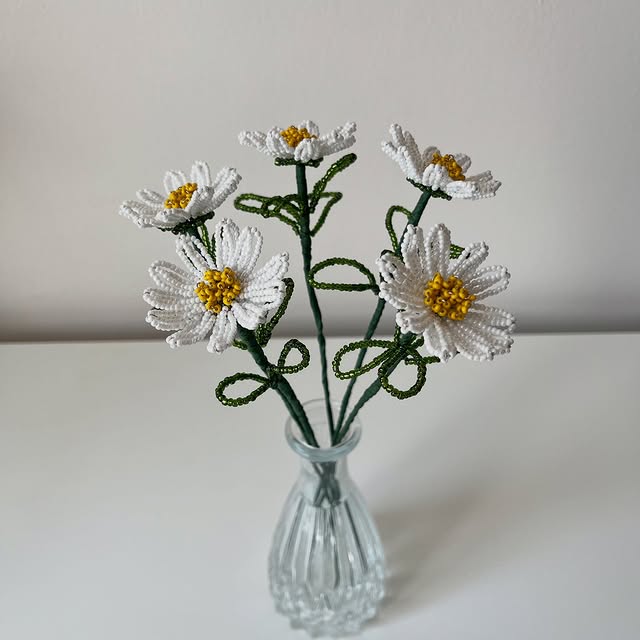Okay, real talk – I discovered French beading completely by accident while doom-scrolling Instagram at 2 AM, and now I’m obsessed. Like, the kind of obsessed where I’ve accidentally made 17 tiny beaded flowers and my dining table looks like a craft store exploded.
If you haven’t heard of French beading, it’s basically the art of making incredibly realistic flowers and plants using seed beads and wire. Think of it as the sophisticated cousin of those plastic bead crafts we did as kids, except the results are actually gorgeous and you’ll want to display them everywhere.
I have already written about crochet flowers – which I adore – but beading is a totally different craft and gives it a more sophisticated vibe whereas crochet is more of a cozy vibe for me!

What Even Is French Beading?
French beading (also called French wire beading) is a technique that originated in France in the 1800s. Crafters use fine wire and tiny seed beads to create petals, leaves, and entire botanical sculptures. The wire gives structure while the beads add color and texture – it’s like sculpting with sparkles.
The flowers look so realistic that people genuinely ask if they’re real from a distance. I’ve had multiple people try to water my beaded succulents, which is both hilarious and the ultimate compliment.
Why I’m Obsessed (And You Might Be Too)
It’s Actually Meditative Threading beads onto wire is surprisingly zen. It’s repetitive enough to calm your brain but engaging enough that you don’t get bored. Perfect for when you need to keep your hands busy during Netflix marathons.
The Results Are Stunning Unlike some crafts that look obviously handmade, good French beading looks professional and elegant. These aren’t crafts you hide in a drawer – they’re pieces you actually want to display.
It’s More Forgiving Than You Think Real flowers aren’t perfect, so beaded ones don’t need to be either. Slight variations in petal size or shape just make them look more natural.
No Watering Required I have killed so many plants, but my beaded garden is thriving. It’s perfect for people who love botanical aesthetics but have a black thumb.

Getting Started (Without Breaking the Bank)
Essential Supplies:
- Seed beads (size 11 is most common)
- Heavy duty wire cutter
- Wire cutter
- Pliers
- Scissors
- Ruler
- Floral tape
- Bead Spinner
- Component Wire (thin wire for the leaves themselves, copper core wire or florist paddle wire are the most common, you can go between 32 gauges to 22 gauges for different strength)
- Stem Wire (to hold the entire Flower, so needs to be stronger)
Color Strategy: Start with flowers that use 2-3 colors max. Roses in red and green, or daisies in white and yellow. You can always get fancier later.
First Project Suggestions:
- Simple daisies (white petals, yellow center)
- Basic roses (any color you love)
- Forget-me-nots (tiny and adorable)
- Leaves (surprisingly satisfying to make)
It is one of those crafts that is best learned with video. I recommend these two beginner videos. Both channels posted a lot of different french beading tutorials, so it’s a perfect start:
The Basic Technique (Simplified)
Continuous Loops Method:
- String beads onto wire (way more than you think you need)
- Make small loops for petals by counting beads
- Twist loops to secure
- Shape into flower form
- Wrap stem with floral tape
Basic Loop Method:
- Make a small loop at wire end
- String beads for one petal
- Make another loop to close petal
- Repeat for each petal
- Gather and twist into flower
I’m not going to lie – your first attempts might look a bit wonky. Mine definitely did. But there’s something charming about handmade imperfection, and you improve quickly with practice.
What I Wish I’d Known Starting Out
Buy More Beads Than You Think You Need Running out of beads mid-project is the worst. Buy at least 2-3 tubes of your main colors.
Invest in Good Wire Cutters Cheap ones will make your life miserable. Get ones designed for jewelry making – your hands will thank you.
Start Small Don’t attempt a full bouquet on day one. Make individual flowers first, then combine them later.
YouTube Is Your Friend Written instructions are fine, but video tutorials make everything clearer. Watch someone else do it first.
Save Your Fingers The wire can be rough on your fingers. Take breaks and maybe invest in some finger guards if you’re planning longer sessions.
Project Ideas That Actually Work
Beginner Level:
- Single stem roses
- Daisy chains
- Simple leaf sprigs
- Tiny succulents
Intermediate Level:
- Full bouquets
- Potted arrangements
- Seasonal wreaths
- Wedding boutonnieres
Advanced Level:
- Entire floral arrangements
- Detailed botanical sculptures
- Holiday centerpieces
- Custom bridal bouquets
The Therapeutic Angle
I started French beading during a particularly stressful period, and it genuinely helped. There’s something about the repetitive motion and focus required that quiets anxiety. Plus, you end up with something beautiful instead of just stressed-out energy.
It’s also perfect for people who need to keep their hands busy. If you’re a fidgeter or find yourself mindlessly scrolling, this gives your hands something productive to do.

Where to Find Supplies
Online:
- Amazon (good for starter kits)
- Fire Mountain Gems (huge selection)
- Artbeads.com (quality supplies)
Local:
- Craft stores (basic supplies)
- Bead shops (better selection and advice)
- Jewelry supply stores
Pro tip: Join Facebook groups for French beading. People often sell supplies or share bulk buying opportunities.
Making It Your Own
The traditional flowers are beautiful, but don’t be afraid to experiment. I’ve seen people make beaded succulents, fantasy flowers in impossible colors, and even beaded vegetables (yes, really).
Mix bead finishes – matte, iridescent, and transparent beads in the same project create amazing depth. And don’t forget about wire color – copper wire gives a completely different vibe than silver.
The Reality Check
French beading takes time. A single rose might take 2-3 hours when you’re starting out. But that’s also part of the appeal – it’s slow craft in a fast world. You can’t rush it, which forces you to be present.
Also, your fingers will be sore at first. The wire takes some getting used to, and you’ll definitely poke yourself a few times. It’s part of the learning curve.

Why It’s Worth Trying
In a world of digital everything, there’s something deeply satisfying about creating something physical and beautiful with your hands. French beading combines the meditative aspects of repetitive craft with the reward of creating something genuinely lovely.
Plus, these make incredible gifts. I’ve never given someone a beaded flower arrangement that didn’t absolutely love it. They’re unique, personal, and obviously took time and care to make.
P.S. – Start with a simple project and don’t judge your first attempts too harshly. Even wonky beaded flowers have charm, and you’ll be amazed how quickly you improve.





